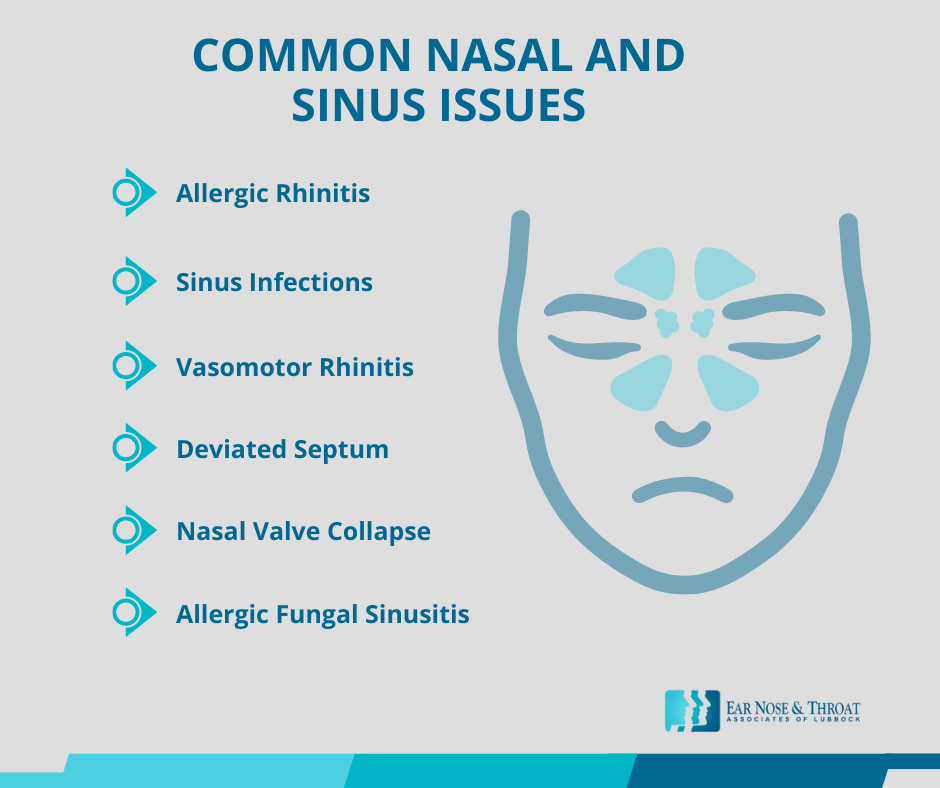6 Common Nasal and Sinus Issues and How To Identify Them

Your nose is an infection-fighting machine.
It’s a self-cleaning organ with mucus and hair cells that trap and push out the bacteria and debris from your environment. It’s a filter between you and the outside world.
But sometimes, that filter gets into trouble.
When the nose and sinuses are functioning properly, you don’t really need to do much to care for them. Maybe you find an occasional saline sinus rinse helpful, but other than that, things work well on their own.
But the nose and sinuses don’t always function properly, and this can give rise to a number of nasal and sinus issues.
6 Common Nasal and Sinus Issues and How To Identify Them
The nose and sinuses are small parts of the body that can cause big problems. Let’s take a look at six of the most common nasal and sinus issues.

1. Allergic Rhinitis
Allergic rhinitis is also sometimes referred to as hay fever or seasonal allergies.
Your immune system’s job is to fight off pathogens that try to enter your body from the environment to prevent them from causing an infection. But sometimes your immune system flares up at inappropriate times, misidentifying a piece of dust or pollen as a dangerous threat to your health.
Allergic rhinitis occurs when the mucosa that lines the inside of the nose becomes thick and swollen in response to this perceived threat. The nose tries to get rid of that pollen with mucus production, which produces the congestion and drainage so many of us are familiar with.
People in all different parts of the world suffer from allergic rhinitis. Here in the West Texas panhandle, we have our own unique allergens. The dust storms, cotton, ragweed, and tumbleweeds can send our immune systems into overdrive, wreaking havoc on our nasal mucosa.
Hallmark signs of allergic rhinitis include a runny nose, sneezing, headache, postnasal drip, and itchy, watery eyes.
2. Sinus Infections
Sometimes nasal swelling from allergies or a viral infection blocks off the opening to your sinuses. When this blockage lasts long enough, mucus and bacteria become trapped, continuing to build up in the sinus cavities.
Sinus infections cause thick drainage, headache, nasal congestion, and facial pain and pressure. You might also experience a fever or fatigue. Sometimes, if a sinus infection lingers long enough, it can even drain down into the lungs and lead to bronchitis.
Although some sinus infections resolve successfully with home remedies, others may require antibiotics.
3. Vasomotor Rhinitis
Vasomotor rhinitis is when the nose just drips and drains on its own.
In people experiencing vasomotor rhinitis, an overly excited posterior nasal nerve sends abnormal signals to the nose, causing excess mucus production. Sufferers then experience either postnasal drip or a runny nose with no apparent cause.
For unknown reasons, vasomotor rhinitis often happens at mealtimes and in the older population. We don’t fully understand the causes of vasomotor rhinitis, but it certainly can be frustrating!
4. Deviated Septum
The wall of cartilage and bone that divides your nose into two halves is called the nasal septum. The septum is usually straight, but it can sometimes deviate to one side, becoming a deviated septum.
We usually associate a deviated septum with a broken nose. While trauma can cause a deviated septum, it doesn’t necessarily have to be a broken nose.
A car crash, sports injury, or other hit to the face could all result in a deviated septum, and some people are even born with a deviated septum.
The main symptom of a deviated septum is congestion that’s more severe on one side of the nose. People with a deviated septum often find it easier to sleep on one side to keep their nasal passages open. Snoring is also a common result.
An ENT surgeon can treat a deviated septum surgically with septoplasty.
5. Nasal Valve Collapse
The nostrils have another, lesser-known name: the nasal valves.
When some people breathe in deeply, the external wall of one or both of their nasal valves caves in. The nose just collapses in on itself and hinders breathing. This is nasal valve collapse.
The primary symptom of nasal valve collapse is difficulty breathing in through the nose. Sometimes a nasal valve remains collapsed all the time, causing constant breathing trouble, and other times it only collapses during intense exercise or exertion.
We can treat nasal valve collapse with over-the-counter remedies like Breath Right Strips, but we’ve also seen great permanent results with the VivAer nasal remodeling procedure.
6. Allergic Fungal Sinusitis
A more difficult sinus issue we sometimes see is allergic fungal sinusitis.
Most often, bacteria and viruses cause sinus infections. But some sinus infections can be caused by a fungus in the air, such as mold.
While a healthy immune system can usually clear this problem, people with immune deficiencies can’t fight it off so easily. This obstruction can lead to production of extremely thick mucus, and the fungus stays trapped in the sinuses with the mucus.
It’s almost impossible to get rid of all the fungus and thickened mucus without surgery to clean out the sinuses.
If allergic fungal sinusitis, or any kind of chronic sinusitis, goes untreated long enough, it can lead to the formation of a mucocele. A mucocele occurs when the mucus is unable to drain for so long that it builds up and puts enough pressure on the sinuses to begin remodeling the bone structures. This can result in facial deformities, even eroding through the skull and eventually into the brain.
This is a rare complication of untreated chronically blocked sinuses.
More Resources for Sinus Issues
Nasal and sinus issues can be a real pain and significantly impact the quality of your life. For more information about dealing with various nasal and sinus issues, take a look at our other articles on the subjects!
Dr. Cuthbertson is a physician at Ear Nose & Throat Associates of Lubbock. He joined the team at ENT Lubbock from Houston, where he was chief resident of the prestigious Bobby R. Alford Department of Otolaryngology at Baylor College of Medicine. He is board certified in Otolaryngology and Head & Neck Surgery and has quickly built a reputation, not only as an extremely skilled surgeon, but as an approachable and compassionate clinician adept in the newest standards and technologies. Learn more about Dr. Cuthbertson.
Categories:








